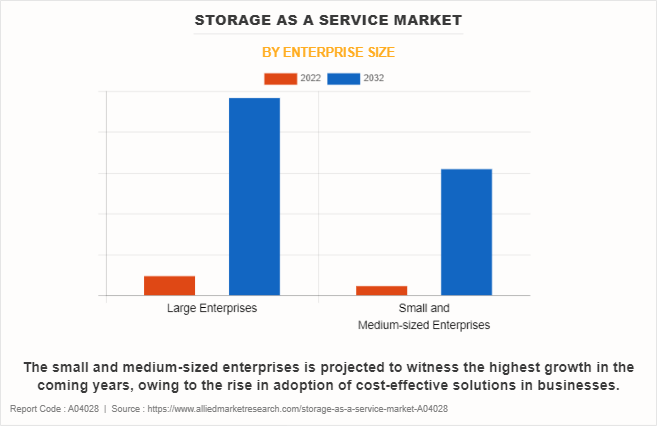Storage As A Service Market Statistics, 2032
The global storage as a service market was valued at $34 billion in 2022, and is projected to reach $396.5 billion by 2032, growing at a CAGR of 28.2% from 2023 to 2032.
The key drivers for storage as a service market are the need to orchestrate cloud-based storage systems, the need to gather, manage and extract value from big data, the increased need for data archiving and government requirements. However, cloud data security concern, bandwidth limitations, and interoperability issues are restricting the growth of the storage as a service market. Moreover, increasing availability of digital infrastructure and the growing usage of mobile devices are anticipated to propel the growth of global storage as a service market during the forecast period.

In addition, the surge in technological advancements, which in turn is expected to create numerous opportunities for the market growth in the upcoming years. Furthermore, increasing demand of digital solution and rise in integration of industry 4.0, which creates lucrative opportunities for storage as a service during the forecast period. For instance, in October 2023, Cloudian, Inc. collaborated with AMD and Micro to announce breakthrough levels of object storage performance and power efficiency.
Storage as a service (STaaS) is a business model that enables large enterprises to rent its storage infrastructure to smaller enterprises to store data. The advantage of implementing STaaS model in the enterprise is reduced cost savings in personnel, hardware, and physical storage space.
Segment Review
The storage as a service market is segmented on the basis of type, enterprise size, application and region. According to the type, the market is classified into cloud NAS, cloud SAN, cloud backup and cloud archiving. Based on the enterprise size, the market is classified into small and medium-sized enterprises and large enterprises. On the basis of application, the market is classified into BFSI, IT and telecom, retail & e-commerce, healthcare, government, media entertainment and others. In addition, it analyzes the current market trends across different regions such as North America, Europe, Asia-Pacific, and LAMEA.

On the basis of enterprise size, the global storage as a service market share was dominated by the large enterprises segment in 2022 and is expected to maintain its dominance in the upcoming years. This is due to the increase in adoption of advanced technologies such as StaaS and other on-premise infrastructure, which drives the growth of the market. However, the small and medium-sized enterprises are expected to witness the highest growth. This is attributed to the rise in adoption of cost-effective solutions in businesses. For instance, in September 2023, Amazon Web Services, Inc. held its annual AWS storage day event that reinforced the value of the platform and launched new features and services that strengthen its storage portfolio.

By region, North America dominated the market share in 2022 for the storage as a service market. The increasing investment in advanced technologies such as cloud-based services, business analytics solution and IoT to improve businesses and the customer experience are anticipated to propel the growth of the storage as a service market. However, Asia-Pacific is expected to exhibit the highest growth during the forecast period. This is attributed to the increase in penetration of digitalization and higher adoption of advanced technology are expected to provide lucrative growth opportunities for the market in this region.
Top Impacting Factors
Surge in demand for flexible and dependable STaaS:
Storage as a service enables companies to deploy and manage stored applications across different infrastructure environments. Such as Cloud NAS, SAS and archive. STaaS enables organizations to choose the infrastructure that best suits their needs. This flexibility not only allows organizations to leverage existing infrastructure investments, but also provides the flexibility to seamlessly migrate applications between environments, facilitating efficient workload balancing and resource optimization.
Furthermore, with the help of STaaS platform, companies can scale stored applications up or down as needed. This scalability ensures that applications can handle changing workloads and sudden traffic spikes without impacting performance or incurring additional infrastructure costs. In addition, STaaS offers a reliable solution for running stored applications. They provide robust orchestration and management capabilities ensuring that containers are properly deployed, monitored, and maintained. Moreover, STaaS often incorporates features such as load balancing, fault tolerance, and automatic scaling that improve application reliability and availability. Therefore, these trends are driving the growth of the storage as a service market.
COVID-19 Impact Analysis
The pandemic necessitated a rapid shift to remote work and increased reliance on digital technologies. Organizations quickly recognized the need to modernize their IT infrastructure and embrace cloud-native approaches. STaaS emerged as a crucial enabler, allowing businesses to efficiently deploy and manage applications in a distributed environment.
This accelerated digital transformation had spurred the demand for STaaS offering. Moreover, the pandemic has posed unprecedented challenges, requiring businesses to respond quickly to changing market dynamics. STaaS provided the agility and scalability needed to meet these demands. With stored, applications can be easily packaged and deployed to different environments, enabling organizations to rapidly scale their operations.
This flexibility became paramount as organizations needed to adapt rapidly to evolving customer needs and market conditions. Furthermore, StaaS helped organizations optimize costs by improving resource utilization and reducing infrastructure overhead. This became particularly important as companies sought ways to optimize expenses during the economic downturn caused by the pandemic. Therefore, the COVID-19 pandemic had a positive impact on the storage as a service market size.
Competition Analysis
The market players operating in the storage as a service market are IBM Corporation, Microsoft Corporation, AWS Inc., HPE, Google LLC, Dell Technologies, Rackspace Inc., AT&T, Quantum Corporation, and Cloudian, Inc. These major players have adopted various key development strategies such as business expansion, new product launches, and partnerships, which help to drive the growth of the storage as a service market globally.
Key Industry Development
Recent Product Launch in the Storage as a service Market
In October 2023, Microsoft Corporation's Azure storage upgraded its services to offer highly available, massively scalable, durable, and secure storage for a variety of data objects in the cloud.
In April 2023, Quantum Corporation launched Quantum Myriad, an all-flash, scale-out file and object storage software platform for the enterprise.
In May 2021, Dell Technologies launched data storage, cloud-as-a-service options. Dell's new Apex data storage and cloud services aim at HPE GreenLake and other as-a-service options that bring the public cloud operating model to on-premises infrastructure.
Recent Business Expansion in the Storage as a service Market
In June 2023, Rackspace Technology expanded its services and worked with Pure Storage to amplify the performance of its storage-as-a-service with Google Anthos to deliver on-premises performance in a cloud-like environment.
Key Benefits for Stakeholders
The study provides an in-depth analysis of the Storage as a service market along with the current trends and future estimations to elucidate the imminent investment pockets.
Information about key drivers, restrains, and opportunities and their impact analysis on the Storage as a service market size is provided in the report.
The Porter’s five forces analysis illustrates the potency of buyers and suppliers operating in the Storage as a service industry.
The quantitative analysis of the global Storage as a service market for the period 2022–2032 is provided to determine the Storage as a service market potential.
Storage as a Service Market Report Highlights
| Aspects | Details |
| Market Size By 2032 | USD 396.5 billion |
| Growth Rate | CAGR of 28.2% |
| Forecast period | 2022 - 2032 |
| Report Pages | 251 |
| By Type |
|
| By Enterprise Size |
|
| By Application |
|
| By Region |
|
| Key Market Players | Microsoft Corporation, Rackspace Techonology, Hewlett Packard Enterprise Development LP, AT&T, Quantum Corporation, Amazon Web Services, Inc., Google LLC (Alphabet Inc.), Dell Technologies, Cloudian, Inc., IBM Corporation |
Analyst Review
As the storage as a service industry continues to evolve, the storage as a service (STaaS) industry represents a strategic opportunity to transform how organizations manage and leverage their data assets. As data continues to be important for business operations, STaaS offers an attractive value proposition. It enables scalability on-demand, eliminating the need for significant upfront capital investment, aligning with cost-efficiency goals. Moreover, STaaS supports data accessibility and security, a crucial concern in an era of remote and hybrid work. The pay-as-you-go model aligns well with budgetary flexibility, allowing for cost-effective resource allocation. In addition, STaaS supports strategic digital transformation initiatives, offering a platform for innovation and agility, which is expected to provide lucrative growth opportunities for the market growth during the forecast period. However, CXOs need to weigh the benefits against potential risks, such as data privacy and compliance challenges, and to ensure that their STaaS strategy aligns with their long-term business goals. As a result, the businesses strategic perspective, prioritizing customer experience, cost-efficiency, agility, and innovation to drive the organization's success.
North America is the largest market for the Storage as a Service.
Increasing availability of digital infrastructure and the growing usage of mobile devices are anticipated to propel the growth of global storage as a service market during the forecast period.
Storage as a Service Market is expected to Reach $396531.71 Million, by 2032.
The key growth strategies for Storage as a Service include product portfolio expansion, acquisition, partnership, merger, and others.
The market players operating in the storage as a service market are IBM Corporation, Microsoft Corporation, AWS Inc., HPE, Google LLC, Dell Technologies, Rackspace Inc., AT&T, Quantum Corporation, and Cloudian, Inc.
Loading Table Of Content...
Loading Research Methodology...



